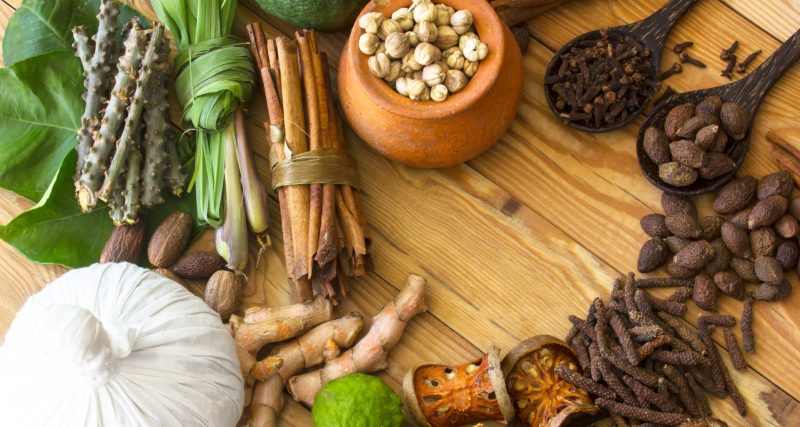Ayurveda is India’s traditional science. It is a science of medicine and a whole way of life. The practice of Ayurveda enables everyone to follow a healthy lifestyle. It promotes nutritious food and a good lifestyle as a preventive measure to avoid any diseases and the need for medicines. India has been the pioneer in making the world aware of this magnificient creation of theirs. India has a rich biodiversity with a varied range of geographical and climatic conditions. Our forefathers have always acknowledged the importance relationship between trees, forests and herbs with animals, birds and insects in maintaining a thriving ecosystem. Humans and trees have an interdependent relationship with each other.
Plants are a source of food, oxygen, different materials, and even medicine for humans. That is probably why some trees have been considered holy and been worshipped traditionally for ages. As is well-known, Ayurveda is a system that largely relies on plants and herbs. This ancient science is India’s heritage and needs to be revived and propogated. Centuries ago, our ‘rishis’ developed Ayurveda as a holistic way of life, keeping in mind that all day-to-day life processes of humans should get and remain synced with Nature. In Ayurveda, the focus has been on personalization, as each one’s physical constitution is variable. The individual’s Prakriti is taken into consideration while planning daily routine as well as clinical assessment.
The Golden Era:
Atharva Veda is the 4th/last of the 4 Vedas of Hindu literature. It covers all the daily rituals for healthy living, healing the illnesses with herbs and plants, etc. This Veda can be considered the earliest documentation of medicine, breathing techniques, and yoga practice; meaning it is the origin of Ayurveda. Ayurveda covers both preventive and curative aspects. With the advent of 2 treatises, Charak Samhita by Charak (a physician) and Sushruta Samhita by Sushruta (a surgeon), Indian traditional medicine entered its golden period.
ADVERTISEMENT
Guru-Shishya parampara came into being. It helped propagate the knowledge of Ayurveda & implementing the teachings in the day-to-day life of commoners. In the 7th century, there was a Department of Ayurveda at Takshashila University. The library housed a vast collection of documents about plants and herbs. The archives spoke about the cultural importance and medicinal properties of the plants.
Ayurveda flourished during the ancient and medieval periods in India. However, when the Britishers invaded India, initially, they took an interest in the practice of Ayurveda. They were intrigued enough to establish courses in Sanskrit and Ayurveda (in English) to make ‘native doctors’ available for the British Company. The courses were started at Bombay and Calcutta Native Medical Institution. However, there clearly was a hidden motive to recruit native doctors to get a degree in Ayurveda. It was done to make the doctors realise the difference between ancient and modern medicine and recognize the superiority of Modern medicine!
Britishers propagated modern medicine more because of a highly secure feeling backed by scientific research. The Britishers firmly believed that Ayurvedic practices were blindly followed with only practical knowledge as evidence and revered as a ‘Gift from God.’ Christian Missionaries also found a wide scope in India, making their lady doctors available here. Indian midwives or ‘dais’ were painted as backward and superstitious. Their techniques were considered barbaric, and the high mortality of ladies during pregnancy or childbirth was blamed on the primitive practices. Instead, West trained mid-wives were pronounced progressive and humane. Their techniques were deemed more refined.
ADVERTISEMENT
The Company gradually withdrew its backing and promotion of the indigenous Indian medical system. The strategic disintegration eventually led to loss of faith in practitioners of native systems. Whereas, the Western practitioners who were considered the torchbearers of sound and best medical practices in India, saw a rise in admirers. Some Indian practitioners stood up for our ancient sciences.
Mr. M. M. Gananath Sen from Bengal founded an Ayurvedic College and a manufacturing unit for Ayurvedic medicines. Many such attempts were seen for the resurrection of Ayurveda in the following waves of patriotism. The local medicine practitioners refused to get acquainted with Western Medicine as a mark of respect for their knowledge of traditional medicine.
The Black Times:
In the 1920s, Benaras Hindu University introduced a course that offered knowledge of both, Ayurveda and Western medicine. Many efforts were put into harmonizing both the local & ancient with the Western & modern. As it is, no one science is complete in itself. The amalgamation of a variety of sciences working in concert for a higher purpose can positively impact the society. However, the mingling of the two contrast medicinal sciences was also seen as a cause for fusion of two incompatible cultures.
ADVERTISEMENT
Ayurveda was so deep-rooted amongst Indians, that it primarily became their culture and lifestyle, rather than a medical science. Thus, there was initially a lot of resistence in accepting western restorative practice. Gradually, the scenario changed, and the next generation of people either became more accepting or were forced to move toward western medicine, food, and culture. The outcome of this transformation was that the loyal practitioners of Indian medical systems started garnering inferior treatment, sometimes from their own countrymen. Unfortunately, even after almost 75 years of overthrowing the British rule, the scenario has not changed much in India.
Western medicine has not only maintained, but has managed to boost its popularity. Today’s younger generation, born and brought up in an air of controversy about our ancient medical practices, naturally but wrongly believes that Western Medicine alone is reliable. With the spurt in Industrialisation and Capitalism, the focus stayed on promotion and production of allopathic medications. People have become used to instant relief provided by allopathy, though it mainly treats just the symptom leaving the cause unattended. These days, the need to earn for survival and stay afloat has compelled some Ayurvedic practitioners to prescribe allopathic drugs.
The attempt to Transform:
Many attempts have been made to revive the ancient and traditional medicinal practices by India, such as setting up committees like Shrivastav and Bajaj committees. They have tried to alter the curriculum of medical courses in India, as it had stayed almost the same since the time of the British Raj. In 1995, a new govt department of Indian Systems of Medicine and Homeopathy was created to revitalize indigenous medicine. It was renamed as Department of Ayurveda, Yoga, and Naturopathy, Unani, Siddha, and Homeopathy in Nov 2003. It laid the foundation for promoting and upgrading native and ancient sciences, standardization, and QC of drugs. The department also concentrated on reforming the educational standards and boosting research in this field.
In 2014, AYUSH Ministry ( ayush.gov.in) Ayurved, Yoga & Naturopathy, Unani, Siddha – Sowa-rigpa, Homeopathy, etc. came into being. It is responsible for education, research, and propogation of alternative and indigenous medical systems. The Ministry finally got its due recognition amongst the masses with the recent covid pandemic. Unfortunately, the world turned to traditional medicines as a second resort while waiting for Modern Science to churn out vaccines and medication for coronavirus.
Our Hon PM, Mr. Modi, has been putting in special efforts to highlight the work of the AYUSH Ministry. His work to bring our traditional medicine, food, art, etc., back to the mainstream is laudable. Who would have thought that convincing Indians, out of everyone else, of their own creation (Ayurved, etc.) would be an arduous task! But trust our PM to turn obstacles into opportunities! It took a pandemic of Covid’s magnitude for us to realize the significance of a strong immunity and the role of good lifestyle in it. The elucidation of good lifestyle is already mentioned in our very own Ayurveda. Not long into the pandemic did we realize that all Modern problems DON’T HAVE a Modern solution!
On days of despair around, with no hopes of any cure in near future, the alternative medicine proved a bright ray of hope. The authentic yet simple preventive guidelines issued by AYUSH Ministry helped many gain immunity to avoid and fight the infection; and even regain their strength post the illness. The ‘AYUSH kadhaa’ gained immense popularity during the first lockdown phase. Since COVID has become a part of our life, the Ministry has also issued recommendations for mental health and increasing mental strength (satvabala). They have stressed on maintaining a healthy lifestyle and a sustainable diet that the general public can follow. The initiatives by the Ministry helped create awareness about traditional medicine, Yoga, meditation and pranayama. People started reading about Yoga and practicing it too. Meditation became a part of the daily routine for many.
Recently, the DG of WHO, Dr. Tedros (tag), and our Hon PM (tag) signed a host country agreement to establish Global Centre for Traditional Medicine in Jamnagar, Gujarat. The WHO GCTM will be found under AYUSH MInistry, and it will be one of its kind international hub for traditional medicine and will also propagate global wellness. AYUSH Ministry organized its first Summit in April 2022, The Global Investment & Innovation Summit, held in Gandhinagar, Gujarat. It was inaugurated by none other than our Hon. PM Mr. Narendra Modi. The occasion was graced by the CM of Gujarat, Mr. Bhupendra Patel, WHO DG Dr. Tedros, and PM of Mauritius, Mr. Pravind Jugnauth. Our PM conferred Dr. Tedros with the name of ‘Tulsibhai” to great applause from the audience. Mr. Pravind Jugnauth mentioned in his speech that Mauritius has been celebrating Ayurveda Day since 2017, annually on every Dhanteras. Some agreements have also been signed between the two countries for propagating Indian traditional medicine through research and development.
The new agenda announced at the inauguration by our PM included AYUSH Visa, AYUSH Park, and AYUSH Mark, amongst others. These futuristic schemes will help in making India a Vishwa Guru or the World Leader in Ayurveda. As Mr. Modi mentioned in his speech, Ayurveda is an all-inclusive and diverse science. This is very true, as the theories that came into existance centuries ago are practically applicable even today. Not only Indians but a person from any part of the world can benefit by following Ayurveda because of its personalized approach.
As a part of the Summit, a MasterChef competition was organised. The theme was ‘Aahar for Poshan’ (Diet/Food for Nutrition). It was a meticulously planned and well-organized competition with an expert panel’s critical examination of the preparations. The criteria for the selection of recipes were based on ‘Heal in India, Heal by India’, a thought that Mr. Modi put out in his speech. This idea will be the basis of all the near-future work agenda of the AYUSH Ministry.
Reference Links
Bonus Tip: Consider doing fun and different activities every day. This has proven to be a very strong point for many people to turn their day around. Try adding small elements to your daily routine that will have a tiny positive effect on your life. Watching a funny video, reading an inspirational quote, and visiting fun sites like fortune-telling websites, could have a positive effect on your life.








